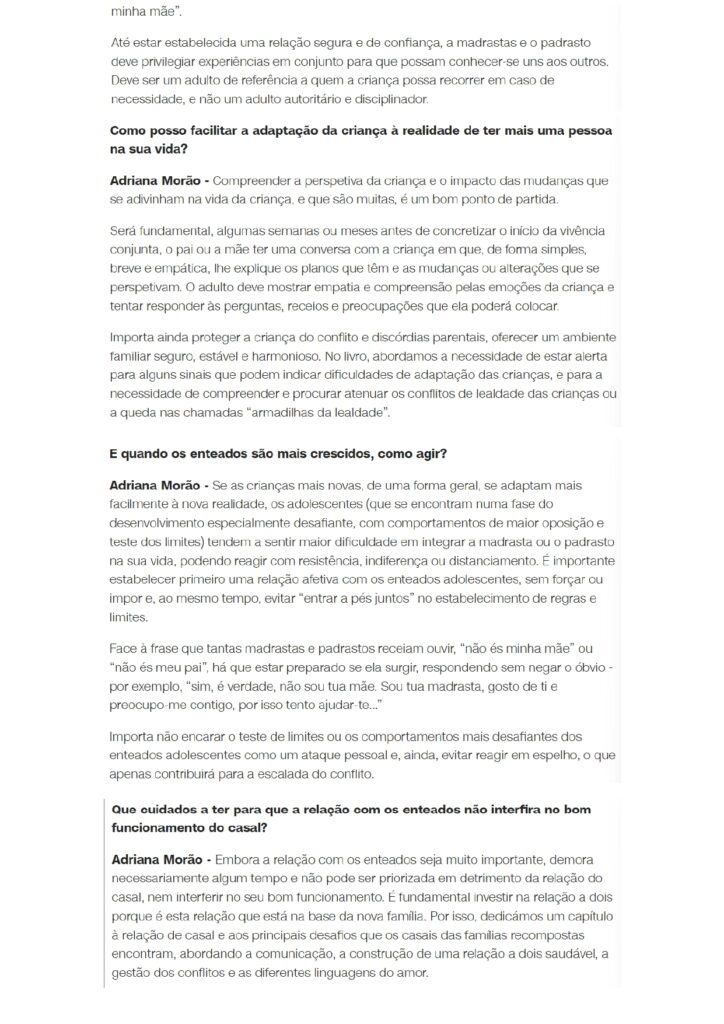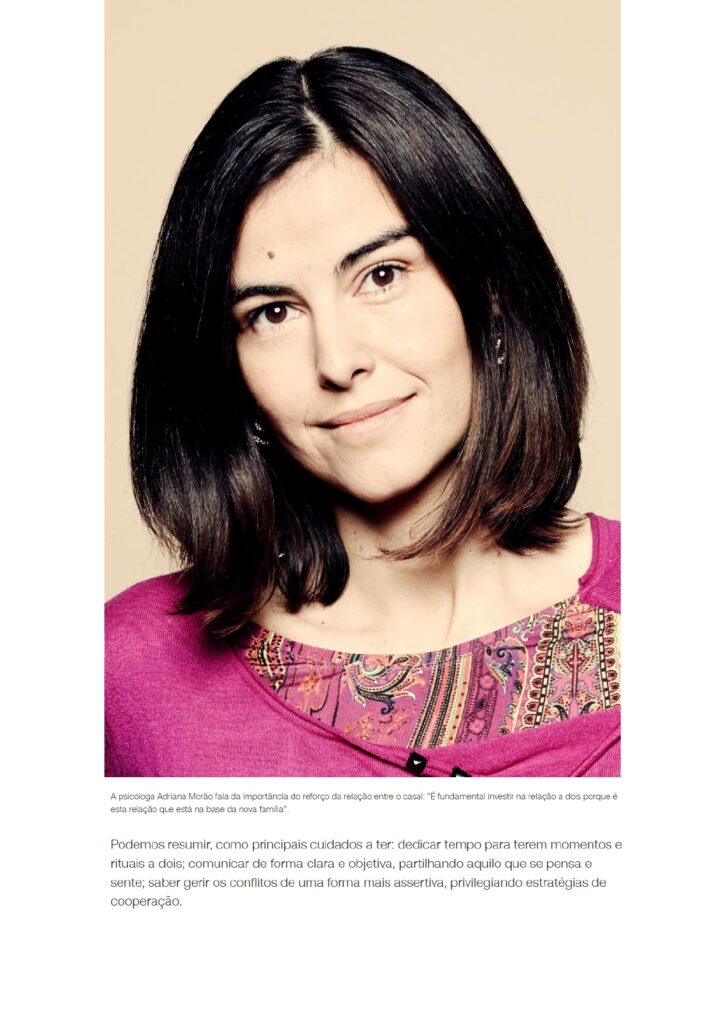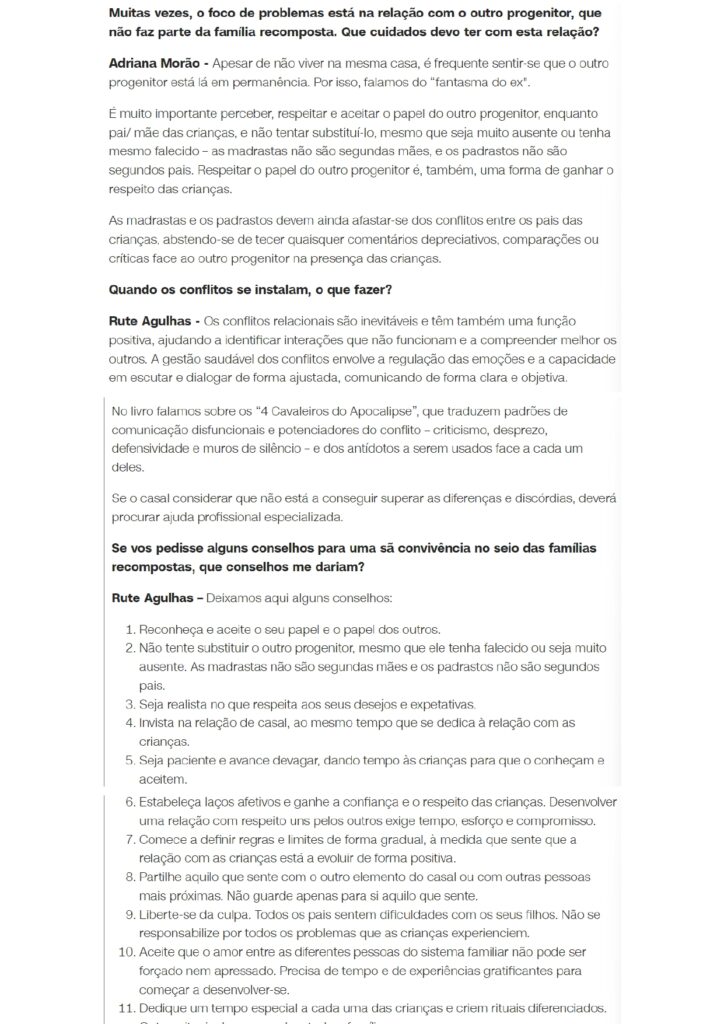Our coordinator, Dr Nuno Cardoso-Ribeiro, together with Dr Adriana Morão and Dr Rute Agulhas, spoke to CNN Portugal about their book “Sou Madrasta ou Padrasto… E agora?”.
Read the article on the CNN Portugal website or the translation and as a pdf bellow:
“With the number of divorces increasing, the number of blended families is also on the rise. There are increasingly more stepmothers and stepfathers, and, if nothing prepares us to become parents, even less do we get prepared to be part of a family already formed, which, on top of it, results from a loss. Nothing prepares us to love and raise children and adolescents who are not our own flesh and blood.
Provisional data from Pordata for 2022 show 50 divorces for every 100 marriages. These rates were even higher during the years of the pandemic, surpassing 91% in 2020. However, they are still much higher than in the 1960s when the ratio of divorces to marriages didn’t exceed 1%. The reality of families has changed, and it’s no longer just parents and children. “Yours, mine, and ours” is increasingly becoming the new normal.
Being a stepmother and stepfather is a role that is becoming more common, and it’s not all smooth sailing. The book “Am I a Stepmother or Stepfather… and Now What?” was created to debunk myths and address the doubts and anxieties of many blended families. Psychologists Rute Agulhas and Adriana Morão, along with lawyer Nuno Cardoso-Ribeiro, tackle the topic in a book that aims to inform but, above all, serve as a catalyst for reflection and a subject for interaction.
In the book, a very clear distinction is made between a “nuclear family” and a “blended family.” Why is this distinction important? How do we classify a family that already has children in common?
Rute Agulhas – Nuclear families and blended families are very different family structures, primarily because not all their members share blood ties. In nuclear families, the couple’s relationship is typically established before the birth of the children, roles for all members are clearer and more defined, and the different children have fixed positions in the sibling hierarchy. These families have a shared history and tradition over time, which facilitates family cohesion and a collective memory. In contrast, in blended families, the relationships between parents and children precede the couple’s relationship, and some members may lack blood ties. The relationships among different family members may not be as close, and roles can be more ambiguous. Additionally, in these families, children divide their time among multiple households, potentially experiencing conflicts of loyalty between parents or between one parent and a stepmother or stepfather.
Blended families are not the same as nuclear families. They are transitional families with a history and are very different from nuclear families in terms of their diversity and complexity and how their members organize and relate to each other.
When, in addition to “my” and “your” children, there are also “our” children who share the same parents, they are considered part of the nuclear family. For the other members of the family system, the term “blended family” still applies.
What are the major challenges that blended families face regarding children from previous relationships?
Rute Agulhas – There are various challenges that these families face. Perhaps we can highlight the fact that there is no shared history and collective memory, meaning that the various family members have separate life paths that were not shared in common. This can hinder family cohesion and feelings of belonging.
Another very common difficulty experienced is related to the fact that, in blended families, roles are often more undefined, which can lead stepmothers and stepfathers to sometimes feel like “outsiders” who landed in that family without knowing exactly how they should interact with their stepchildren.
On the other hand, blended families often emerge from previous losses (separation or divorce) that resulted in a cascade of changes, which, in most cases, were accompanied by suffering, stress, and unexpected negative changes. This “cascade” reoccurs when a new family reality begins with new rules, roles, rituals, and routines.
We should also highlight the specter of the “ex” (the other parent of the child), often perceived as a threat to the new family dynamic, which can negatively impact the couple’s relationship. The relationship with the “ex” can also be strained when stepmothers or stepfathers try to assume the role of a second parent. Mothers and fathers are irreplaceable, and it’s important for everyone in the family to understand this.
Some problems in blended families can be exacerbated by various myths or false beliefs.
In the book, you talk about various myths and aim to debunk them. What are these myths, and why do they persist when we have an increasing number of blended families?
Adriana Morão – When we talk about myths, we refer to false ideas or beliefs that, despite being contradicted by facts and scientific research, are assumed to be true. For example, “The Disney Myth” was created and fueled by societal unfamiliarity with blended families and popularized in fairy tales and children’s literature.
The problem with this and other myths is that they lead stepmothers and stepfathers to develop unrealistic expectations, which will influence their attitudes and behaviors, how they assess and interpret situations, and how they respond to them.
Overly optimistic or “rosy” expectations, such as believing “it will be easy and everything will go well,” can lead stepmothers and stepfathers to not anticipate or prepare for the difficulties and challenges they will naturally encounter because all families face them. For example, they may believe that mutual love with stepchildren will be immediate, an expectation fueled by the “Myth of Instant Love.” However, we know that mutual love cannot be rushed, forced, or imposed; it is built over time with patience and mutual understanding, sometimes taking years to develop. It is also common to believe that the process of acceptance by the children will be effortless, an expectation reinforced by the “Myth of Enthusiastic Reaction.” Stepmothers and stepfathers are then surprised by some of the children’s reactions, which may be contrary to what was expected, marked by opposition, resistance, or indifference. When these excessively optimistic expectations are not met, they can generate feelings of tension, distress, frustration, a sense of injustice, or even doubts about “what am I doing wrong?”
On the contrary, overly pessimistic expectations, such as thinking “of course, it will go wrong,” can stem from negative myths as well, for example, the “Myth of Impossible Love.” This idea can lead many stepmothers and stepfathers to disinvest from the relationship with their stepchildren right from the start, leading to isolation, hypervigilance, tension, or guilt.
Understanding, reflecting on, and debunking these myths is crucial!
The stepmother is still often seen as “the evil witch who mistreats her stepchildren,” and the stepfather as “the cool uncle who takes the kids to soccer.” Does gender play a role in the prejudice surrounding this issue?
Rute Agulhas – From our experience, there is still a negative connotation associated with stepmothers and stepfathers, both perceived as potentially mean and abusive. We are talking about prejudices that have been greatly amplified by stories in children’s imagination (like Cinderella), perpetuating over time and also manifesting in proverbs or popular expressions (for example: “stepmother’s luck,” “a bad father is better than a good stepfather”).
It’s important to emphasize that these negative perceptions are myths, and there is no evidence to suggest that there are more cases of abuse, neglect, or sexual abuse in blended families than in nuclear families.
Should a stepmother or stepfather establish their own rules and boundaries? If so, when is the right time in the relationship with the stepchild to do so?
Rute Agulhas – Stepmothers and stepfathers should start by building emotional bonds with the children and only then, gradually, begin to establish rules and boundaries. Without this emotional foundation, rules and boundaries are likely to encounter resistance, and it is in this context that the famous phrases “you’re not my father” and “you’re not my mother” often arise.
Until a secure and trusting relationship is established, stepmothers and stepfathers should prioritize shared experiences to get to know each other. They should be a supportive adult to whom the child can turn to in times of need, rather than an authoritarian disciplinarian.
How can I facilitate a child’s adaptation to the reality of having another person in their life?
Adriana Morão – Understanding the child’s perspective and the impact of the impending changes in the child’s life, which are many, is a good starting point.
It’s crucial for the parent to have a conversation with the child a few weeks or months before the cohabitation begins, explaining their plans and the changes or alterations that are anticipated in a simple, brief, and empathetic manner. The adult should show empathy and understanding for the child’s emotions and try to address any questions, fears, and concerns the child may have.
It is also important to protect the child from parental conflicts and discord, providing a safe, stable, and harmonious family environment. In the book, we discuss the need to be alert to signs that may indicate children’s adaptation difficulties and the need to understand and mitigate children’s loyalty conflicts or falling into what we call “loyalty traps.”
When stepchildren are older, how should you act?
Adriana Morão – Generally, younger children adapt more easily to the new reality, while adolescents, who are in a particularly challenging phase of development marked by increased opposition and testing of boundaries, tend to have greater difficulty in integrating a stepmother or stepfather into their lives. They may react with resistance, indifference, or distancing. It’s important to first establish an emotional relationship with adolescent stepchildren without forcing or imposing and, at the same time, avoid immediately setting rules and boundaries.
When faced with the phrase many stepmothers and stepfathers fear hearing, “you’re not my mother” or “you’re not my father,” it’s important to be prepared if it comes up and respond without denying the obvious – for example, “yes, it’s true, I’m not your mother. I’m your stepmother, I care about you, and that’s why I try to help you…”
It’s important not to perceive limit-testing or challenging behaviors from adolescent stepchildren as a personal attack and, furthermore, avoid reacting in kind, as this will only contribute to an escalation of conflict.
What precautions should be taken to ensure that the relationship with stepchildren does not interfere with the healthy functioning of the couple?
Adriana Morão – Although the relationship with stepchildren is very important, it necessarily takes some time and cannot be prioritized at the expense of the couple’s relationship or interfere with its healthy functioning. Investing in the couple’s relationship is crucial because it forms the foundation of the new family. That’s why we dedicated a chapter to the couple’s relationship and the main challenges faced by couples in blended families, addressing communication, building a healthy relationship as a couple, managing conflicts, and understanding the different love languages.
We can summarize the main precautions to take as follows: dedicating time to have moments and rituals as a couple; communicating clearly and objectively, sharing thoughts and feelings; knowing how to manage conflicts in a more assertive way, prioritizing cooperation strategies.
Often, the focus of problems lies in the relationship with the other parent who is not part of the blended family. What precautions should I take in this relationship?
Adriana Morão – Despite not living in the same house, it is common to feel that the other parent is constantly present. That’s why we refer to the “phantom ex.”
It is very important to understand, respect, and accept the role of the other parent as the father/mother of the children and not try to replace them, even if they are very absent or have passed away. Stepmothers are not second mothers, and stepfathers are not second fathers. Respecting the role of the other parent is also a way to earn the children’s respect.
Stepmothers and stepfathers should also stay away from conflicts between the parents of the children, refraining from making any derogatory comments, comparisons, or criticisms about the other parent in the presence of the children.
When conflicts arise, what should be done?
Rute Agulhas – Relational conflicts are inevitable and also serve a positive function, helping to identify interactions that don’t work and better understand others. Healthy conflict management involves regulating emotions and the ability to listen and engage in appropriate dialogue, communicating clearly and objectively.
In the book we discuss the “Four Horsemen of the Apocalypse,” which represent dysfunctional communication patterns and conflict escalators – criticism, contempt, defensiveness, and stonewalling – and the antidotes to use when facing each of them.
If the couple feels that they are unable to overcome their differences and conflicts, they should seek specialized professional help.
If I asked for some advice for healthy coexistence within blended families, what advice would you give me?
Rute Agulhas – Here are some pieces of advice:
- Recognize and accept your role and the roles of others.
- Don’t try to replace the other parent, even if they have passed away or are very absent. Stepmothers are not second mothers, and stepfathers are not second fathers.
- Be realistic about your desires and expectations.
- Invest in the couple’s relationship while also dedicating time to the relationship with the children.
- Be patient and take things slowly, allowing the children time to get to know and accept you.
- Build emotional bonds and earn the trust and respect of the children. Developing a relationship with mutual respect takes time, effort, and commitment.
- Gradually start setting rules and boundaries as you feel the relationship with the children is progressing positively.
- Share your feelings with your partner or close individuals; don’t keep your emotions bottled up.
- Let go of guilt. All parents face challenges with their children. Don’t hold yourself responsible for every issue the children experience.
- Understand that love between different members of the family cannot be forced or rushed. It requires time and rewarding experiences to begin developing.
- Dedicate special time to each of the children and create unique rituals. Other rituals should involve the whole family.
- Allow the children to share their thoughts and feelings, creating space for them to ask questions and raise concerns.
- Protect the children from parental discord and conflicts.
- Accept what you cannot change.
Now, let’s move on to legal matters. What legal rights and responsibilities do stepmothers and stepfathers have?
Nuno Cardoso Ribeiro – Our law contains several regulations that govern the relationships between stepmothers or stepfathers and their stepchildren. For example, stepmothers or stepfathers may be called upon to exercise parental responsibilities over their stepchildren; they may refuse to testify in court in criminal proceedings where their stepchild is a defendant, and vice versa; the adoption of stepchildren by a stepmother or stepfather has more favorable rules; stepchildren may adopt the surnames of their stepmothers or stepfathers, and more.
So, can a stepmother or stepfather be called upon to exercise parental rights for a child? If so, under what circumstances?
Nuno Cardoso Ribeiro – In the event of the impediment or death of the parents, stepmothers or stepfathers may be called upon to exercise parental responsibilities. In fact, in these cases, they even have a preference over grandparents, for example, which reflects a highly questionable choice by our legislator.
Do they have the right to visit their stepchildren?
Nuno Cardoso Ribeiro – The Civil Code expressly states that only ascendants (such as grandparents, great-grandparents, etc.) and siblings can claim contact with a child or young person (Article 1887-A). Consequently, the legal provision excludes a number of individuals who may have established a very significant relationship with the child or young person, which should be preserved in the child’s best interests. Our courts, recognizing this, have accepted that, in addition to grandparents and siblings, other people may successfully claim a contact regime with the child or young person. In such cases, this may include aunts, uncles, and godparents, for example, and there is no reason why the same understanding should not be extended to stepmothers and stepfathers. Therefore, in our opinion, although the law does not expressly provide for it, the courts may establish contact regimes between a stepchild and their stepmother or stepfather whenever it is in the child’s best interests.
Can a stepmother or stepfather be required to pay child support for their stepchild? If so, under what circumstances?
Nuno Cardoso Ribeiro – A stepmother or stepfather may be required to pay child support to their stepchild under 18 years old if, at the time of the spouse’s death, the child was under their care. However, it is important to note that stepmothers or stepfathers occupy the last category of individuals obligated to provide support, and they will only be called upon to do so if the primary individuals obligated to provide support are unable to fulfill their obligations. In the first instance, this obligation falls on grandparents, great-grandparents, siblings, and uncles, with stepmothers or stepfathers only being called upon if none of them is in a position to pay child support to the child or young person.
Indirectly, it may also happen that a stepmother or stepfather is called upon to pay for expenses related to their stepchild. Married individuals are obligated to contribute to household expenses, and naturally, this includes the support of children who are the offspring of both spouses or of one or the other.
In the case of divorce, on the other hand, there may be an obligation to pay alimony from one former spouse to the other. In calculating the amount of alimony to be paid, the expenses for the support of the children under the care of the alimony recipient will be taken into account.”









